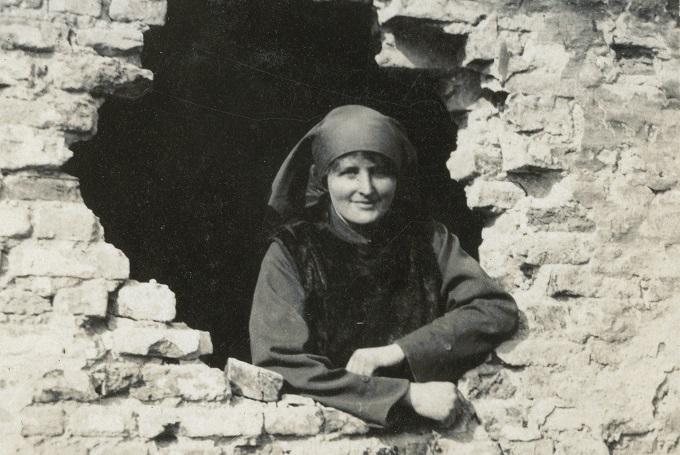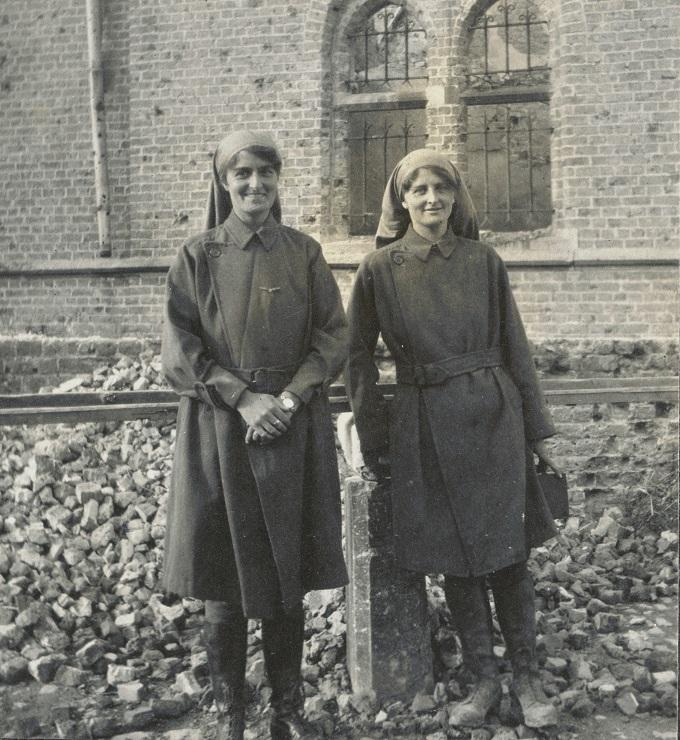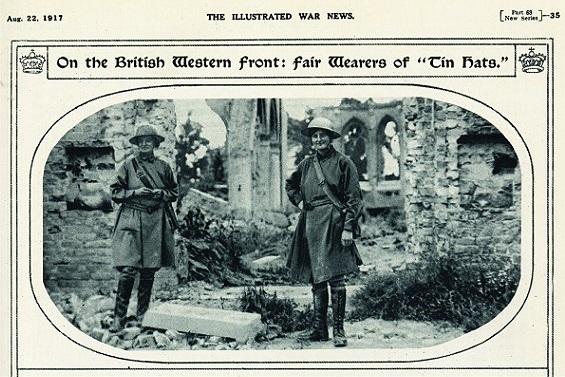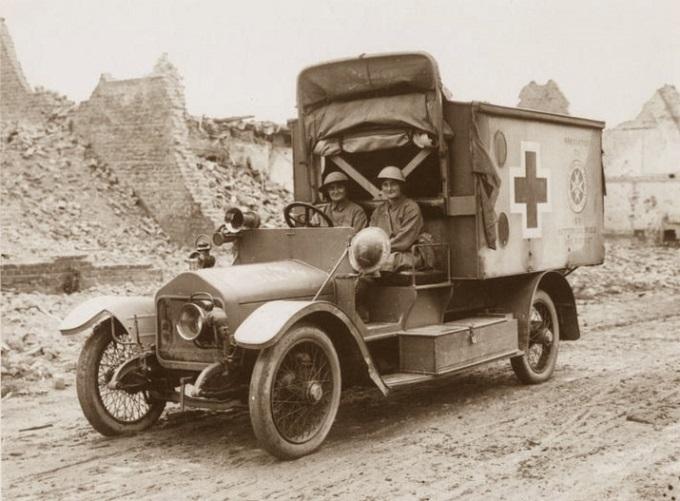
Mairi Chisholm looking through a shell hole, nd.
Credit: The National Library of Scotland, Acc.8006
Early life
First World War
Post-war and later years
Archives
Further reading
Early life
Mairi Lambert Gooden Chisholm, of Chisholm (1896-1981), known as Mairi Chisholm, was an ambulance driver and first aider on the Western Front in Belgium during the First World War. Chisholm and her friend, Elsie Knocker, who were known as the ‘women of Pervyse’ (the French spelling of 'Pervijze'), saved the lives of thousands of soldiers and won numerous medals for bravery. To commemorate Remembrance, we have chosen to investigate Chisholm’s extraordinary life and achievements.
Chisholm was born on 26th February 1896 in Datchet, Buckinghamshire. She was the daughter of Captain Roderick Gooden Chisholm (1864-1943), Chief of Clan Chisholm, and Margaret Fraser (d. 1943). She also had an older brother, Uailean Hamish McUistean (1894-1929), and a younger sister, Lucy Margaret (1906-1996).
Chisholm’s parents had married three years earlier on 12th July 1893 at the Free Church in Nairn.

Entry for Captain Roderick Gooden-Chisholm, Captain 3rd Battalion Seaforth Highlanders, and Margaret Fraser, in the statutory register of marriages for Nairn, 12th July 1893.
Crown copyright, National Records of Scotland, 1893/123/20.
Chisholm was brought up in Hampshire and Dorset. Her older brother, Uailean, owned a Royal Enfield 425cc motorcycle, and she watched him compete at rallies and at the Bournemouth speed trials. Her father bought her a Douglas motorcycle and she learnt how to strip down the machines and repair them. She was 18 years old when she encountered the 30-year-old Elsie Knocker, a divorcee and a mother of a young son, who shared the same passion for motorcycling, and they became good friends.
First World War
At the outbreak of the First World War, Chisholm and Knocker travelled to London on motorcycles to offer their services to the War Office. They were working as dispatch riders for the Women’s Emergency Corps, when their motoring skills were spotted by Dr Hector Munro, a Scottish doctor and founder of the volunteer Flying Ambulance Corps (FAC), and they were invited to join them. At the end of September 1914, they left for Belgium as part of the FAC. They spent the first few weeks on the Yser front where they collected bodies and transported them back to base hospitals.

Elsie Knocker and Mairi Chisholm, nd.
Credit: The National Library of Scotland, Acc.8006
In November, they decided to leave the corps and set up a first aid post in a cellar in a badly damaged house at Pervijze, north of Ypres, which was only one hundred yards from the trenches. The “Poste de Secours Anglais” (British First Aid Post”), would be their home for the next three and a half years where they tended to the wounded.

Mairi Chisholm and Elsie Knocker pose in the ruins of a church in Pervijze, Belgium for "Illustrated War News", 22nd April 1917
Credit: Unknown author. Illustrated War News, Public domain, via Wikimedia Commons
Since they were no longer affiliated with the Belgian Red Cross, they had to raise their own funds. The people of Sutton Coldfield donated a Wolseley ambulance and Chisholm risked her life on a nightly basis, driving the wounded soldiers from the front line at Pervijze to the base hospital. Between 1915 and 1917, she transported 1,500 casualties.

Elsie Knocker and Mairi Chisholm in their converted Wolseley Ambulance, Pervijze, Belgium, c. 1916
Credit: Unknown author. The War Illustrated, Public domain, via Wikimedia Commons
Chisholm and Knocker were the only women permitted on the Belgian front and were highly rewarded for their heroic efforts. In January 1915, they were each appointed by King Albert I of Belgium as Chevalier of the Order of Leopold II. They were awarded the British Military Medal and made Officers of the Most Venerable Order of the Hospital of St. John of Jerusalem. Chisholm was also awarded the Queen Elisabeth Medal of Belgium and British campaign medals.
Campaign medal card of Mairi Gooden Chisholm, British Red Cross Society, 19th November 1917
Crown copyright, The National Archives, WO 372/23/90310
In March 1918, they were both badly affected by a bombing raid and gas attacks on their field hospital and were invalided home. Chisholm was able to return briefly to Pervijze, before being gassed again; she was only 22 years old. When she returned to Britain, she saw out the rest of the war with Knocker as members of the newly formed Women’s Royal Air Force.
Post-war and later years
After the war, both women went their separate ways. Chisholm’s health had been badly affected. She had been poisoned, contracted septicemia and had a weak heart. She relocated to her friend May Davidson’s family estate, Cantray, in Nairn in 1921, where they became successful poultry breeders. She continued her interest in motor vehicles and drove a Sunbeam sports car into her eighties. She also became interested in Chisholm family history and helped revive the Clan Chisholm Society in the 1950s with her nephew, the Clan Chief. Her later years were spent at Cnoc an Fhurain in Barcaldine, Argyll, where she ran a poultry farm with Davidson and friends. Chisholm died aged 85 of lung cancer on 22nd August 1981 at her home, Cnoc an-Fhurain. (NRS, 1981/526/105).
On Saturday 22nd November 2014, a statue of ‘The women of Pervyse’ was unveiled in the garden of the Hotel Ariane in Ypres, Belgium, 100 years since Chisholm and Knocker arrived in Pervijze and set up their first aid post.

Mairi Chisholm at a table in Pervijze House, nd.
Credit: The National Library of Scotland, Acc.8006
Archives
The National Library of Scotland (NLS) holds The Chisholm Papers, (NLS, Acc.8006), which comprises five volumes of papers and photographs that belonged to Mairi Chisholm.
The Imperial War Museum holds the diaries of Mairi Chisholm and Elsie Knocker (later Baroness de T'Serclaes), together with recordings and transcripts of interviews with Chisholm.
Further reading
Diane Atkinson, ‘Elsie and Mairi Go to War: Two Extraordinary Women on the Western Front.’ Cornerstone 2009
D. Condell, & J. Liddiard, Chisholm, Mairi Lambert Gooden, of Chisholm (1896–1981), ambulance driver and first aider. Oxford Dictionary of National Biography. Retrieved 3 Nov. 2022, from https://www.oxforddnb.com/view/10.1093/ref:odnb/9780198614128.001.0001/odnb-9780198614128-e-67674. (Subscription or UK public library membership required).
D. Condell & J Liddiard, T'Serclaes, Baroness Elizabeth Blackall de [née Elizabeth Blackall Shapter; other married name Elizabeth Blackall Knocker] (1884–1978), ambulance driver and first aider. Oxford Dictionary of National Biography. Retrieved 3 Nov. 2022, from https://www.oxforddnb.com/view/10.1093/ref:odnb/9780198614128.001.0001/odnb-9780198614128-e-67675. (Subscription or UK public library membership required).
National Library of Scotland. 'Experiences of the Great War'.
The Baroness T’Serclaes and Mairi Chisholm, The Cellar-House of Pervyse. (A & C Black, London, 1917)